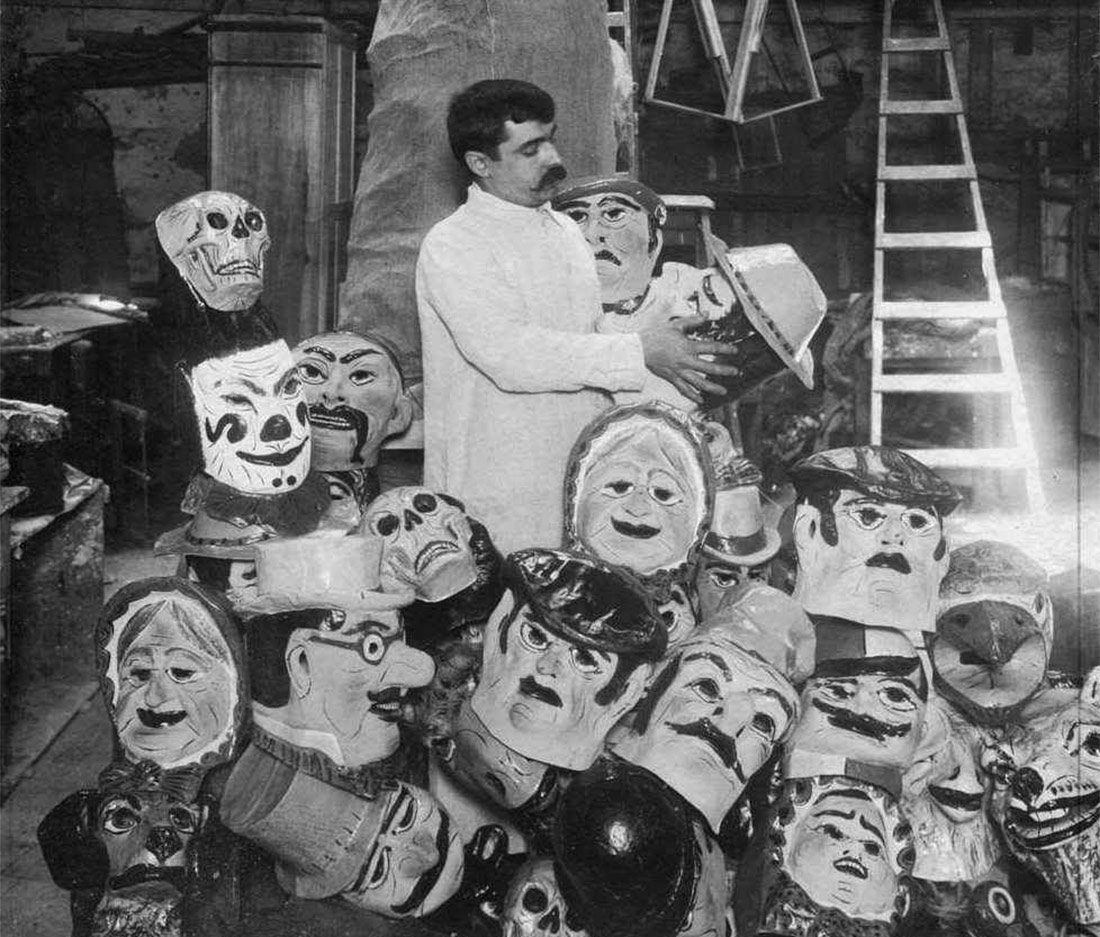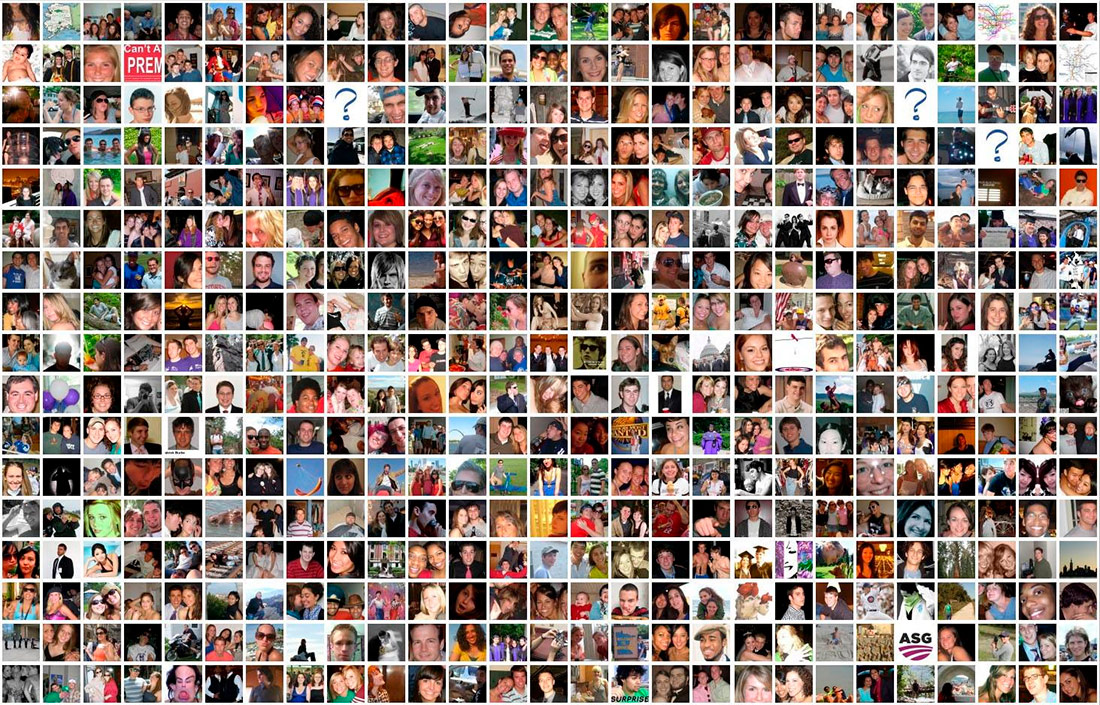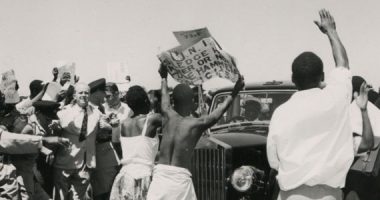
Fàbrica de màscares a Argentina, 1910 | Archivo General de la Nación Argentina | Public domain
In the early days of Internet user anonymity was the norm, with hidden identities offering a way to avoid prejudice and encourage freedom of expression. But with the arrival of social media, the importance of personal exposure has created an ever more personalistic net.
Few inventions have been so conditioned by the mask mentality since their inception as the Internet. In no other medium (except perhaps books) have so many identities been falsified, so many hoaxes spread and, in general, so many lies told as on the network of networks. Number 29 of the “Rules of the Internet”, written by anonymous users of the infamous 4chan forum around 2006, managed to capture the essence of the ubiquitous “digital mask”: “in the internet all girls are men and all kids are undercover FBI agents”. Notwithstanding the delirium that even then prevailed in that dark corner of the net, its users were right to assume that everything on the internet involved a certain percentage of mask.
A brief history of an internet that exists no more
During the period when its use became widespread in the United States and Europe, during the 1990s and 2000s, absolutely everything that could be found on the Internet was mediated by an acknowledged measure of lies. From nicknames to chat rooms, badly indexed eMule downloads, email chains with an unknown original author, and websites that disappeared without explanation, the general image of the Internet at the time was one of permanent turpitude or carnival. During those years, web traffic was spread across a chaotic mesh of blogs, forums and websites whose common denominator was often the fact that members used pseudonyms: “¿quieres identificarnos? Tienes un problema” (You want to identify us? You’ve got a problem), sang the group La Polla Records in 1986.
This anarchic culture of the old-school Internet was able to develop untempered due to the fact that states had not yet developed their technological capacities. Until the major event of 2001 (9/11), states had not been overly concerned about imposing their laws on the digital sphere, as they considered, quite rightly, that it was inhabited by only a small part of the population. Proof of this is that large-scale development of major monitoring programmes such as “Total Information Awareness” (the forerunner to “PRISM”, the global surveillance system uncovered by Snowden) did not get underway until after the New York attacks. Before that we were navigating an internet not unlike the Far West, in which an ageing Sheriff (the state) was utterly incapable of hunting down the new generations of digital Dalton Brothers. Epic pranksterism like that of “The Yes Men”, who registered a website posing as the World Trade Organisation (WTO) and even gave controversial presentations in its name, is inconceivable today.
The mask, an opportunity for mature dialogue
It would be somewhat trivial to say that the main reason why someone chooses to mask themselves is usually to avoid being identified. However, in the digital world, the mask cannot simply be equated with the hood of analogue contexts – an item that is widely used at Black Bloc demonstrations around the world. In the incipient Internet, the use of a singular mask in the form of a nickname fulfilled a qualitatively different objective – to create completely depersonalised communication, turning users into a complete abstraction and thus making it possible to establish a dialogue without the usual prejudices on the grounds of origin, gender or age.
Much of the expectation generated by the Internet in its early days was due to the hope that virtual environments could foster truly mature communication. The ideal was that the only aspect to be assessed would be the quality of the arguments, since the interlocutor was completely unknown. It is also worth remembering that the infrastructures of the early Internet only properly supported text format (which amounts to absolute depersonalisation), so they helped to create the conditions that would allow this “dialogue 2.0” to become a reality. There are plenty of cases of curious teenagers having one-on-one conversations with leading figures in the hacker community or anonymous forum members participating in high-level academic discussions.
The nickname, that alias that formed the cornerstone of the early Internet, gave rise to a sort of virtual “autonomous identity”, deliberately detached from the real one. It was common to have several identities (very few or none under one’s real name) depending on the website, which would then be casually disused or discarded. As the accounts were not accompanied by a quantitative reputational system (i.e. “followed”, “followers”, “likes”), users did not tend to become too attacked to their nicknames, which were of secondary importance in relation to the main thing – the type of arguments that were put forward. The transient identities and lack of quantification systems made it possible to establish a culture based not only on freedom of expression, but also on having equal conditions for all speakers. Likewise, there was also something altruistic in a user investing hours in answering their dialectical adversaries, knowing that their contributions were not made under their real name, and that they would not be recognised outside the limits of the forum.
Virality
As the Internet entered its teenage years (the second half of the noughties), the zeal for nicknames began to wane in favour of real identities linked to people’s real-life names. This was the A.F. (after Facebook) Internet, whose emergence would mean the beginning of the end of the masks that once constituted the substrate of the Internet. Most people would gradually stop separating their real identity and their digital persona, which would become their avatar, while the amount of time spent online also increased after smartphones burst onto the social scene.
There is a before and an after Facebook because, with the emergence of the first modern social network, a large mass of users were captured within a platform that (i) was all-encompassing (not confined to a specific topic), (ii) had a user-friendly interface and (iii) came with with a reputational system. Absolutely all subsequent social networks have been based on these principles, so that they are, in a sense, later remakes of Mark Zuckerberg’s work.

The changes introduced by the big platforms have profoundly affected the way we relate to the digital world. The progressive importance of projection, both of oneself and of one’s own opinions, has unleashed a frenzy of virality, now easily quantifiable thanks to the number of followers and “likes”. On the Internet A.F., the norm is to convey as accurate an image as possible of the human being behind the screen (name, photograph(s), job, place of residence, emotional state, etc.). It would be enough to take a look at the Twitter or TikTok timeline of the average teenager to see the dramatic consequences of this “culture of exposure” that is so essential for gaining virality.
Digital masks, which allowed us to place ourselves on a “2.0” level of debate (free, equal, altruistic), were gradually abandoned as the inseparable personalism of today’s Internet gained ground. Being anonymous is incompatible with being viral. As for the die-hards who continue to use nicknames (especially those who use them to support a minority opinion), they are the object of constant suspicion in an environment that once again places more importance on character than on arguments. In many ways, we have slid backwards.
Finally, it only remains to point out that, nowadays, the use of pseudonyms has been reduced to a “personal brand” of the real person. Influencers and youtubers often use alternative names, although this is clearly not to distance their content from their real identities, quite the opposite – the aim is to stand out from the crowd. In fact, very few people would be familiar with the name Rubén Doblas, but virtually everyone knows the alias “El Rubius” under which he publishes content.
In his case, the degree to which his body has become intertwined with the persona he has created for himself means that his real identity can no longer be disassociated, ever again, from his YouTube account. Doblas has lost the ability to blend in with the crowd, a downside that he may himself have realised in 2018: “you want to do everything 100% and give 100% of yourself, [but] sometimes you can’t cope with so many things. I think I’m going to need some time to look at it all from an outside perspective and, like, still be myself without losing my fricking mind.” Modern influencers have certainly achieved enormous social prominence after adapting their lives wholesale to the principles of exposure and virality – but we have yet to see the effects that this Faustian mentality produces at the psychological, social… and cultural levels.





ron wis | 25 February 2022
Can I make such face for a scarecrow? The expression in the picture given above are quite unique.
Ugo Henrique | 15 March 2022
Enric. Tremendo texto el tuyo, me identifico en afinidades y visiones para descifrar máscaras contemporáneas y el mencionado carnaval digital. Comparto un proyecto que me hizo llegar acá y que ahora mismo estoy mostrando “al mundo”… https://dobleandantemascaras.wordpress.com/
¡Saludos!
Leave a comment